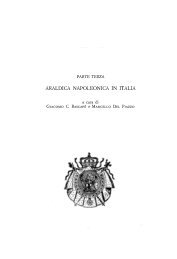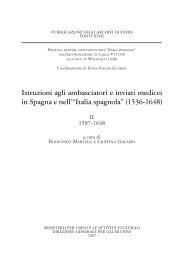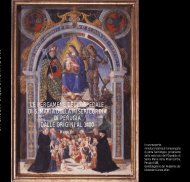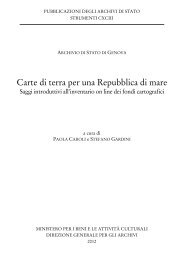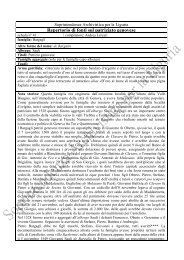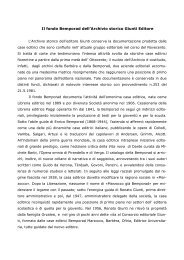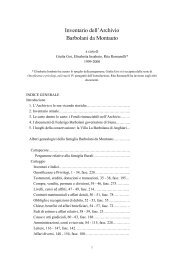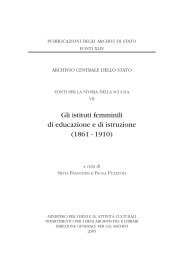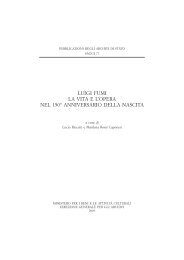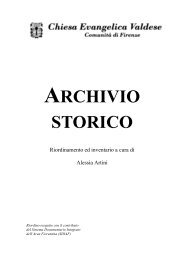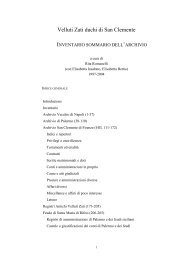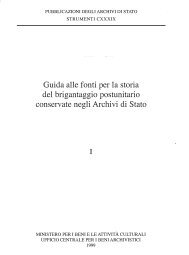esercito e città dall'unità agli anni trenta. tomo i - Sistema ...
esercito e città dall'unità agli anni trenta. tomo i - Sistema ...
esercito e città dall'unità agli anni trenta. tomo i - Sistema ...
You also want an ePaper? Increase the reach of your titles
YUMPU automatically turns print PDFs into web optimized ePapers that Google loves.
194 ANTHONY L. CARDOZA<br />
Incisa's early enthusiasm for the military, and the Cavalry in particular,<br />
reflected the enduring hold of family traditions. As he himself recalled, « io<br />
avevo fin da piccolo fermamente deciso che sarei stato un soldato com'era<br />
stato mio padre, suo padre, e il padre di suo padre: in cavalleria<br />
naturalmente . . . >> 34. The rituals of everyday life in the countryside<br />
recapitulated and revitalized tradition. At an early age, for example, Incisa<br />
an d his brothers learned the intricacies of horsemanship « prima su un ciuco,<br />
poi su un 'ponetto', poi su una 'cavalcatura di campagna' e finalmente su<br />
un cavallo vero » 35. Before they were in their teens, the boys were already<br />
accompanying their father on two or three hour rides several times a week<br />
to oversee the various seasonal agricultural works. Special events such as<br />
the occasionai passage of a cavalry regiment on manuevers through Rocchetta<br />
di Tanaro or the two visits by King Vittorio Emanuele III to the family<br />
villa seemed to make a tremendous impression on the young Incisa and<br />
confirm his commitment t o military servi ce in the Cavalry 36.<br />
For many Piedmontese families, a career in the army not only meant<br />
a gentlemanly pursuit; it also provided much needed work and income to<br />
sons, w ho might otherwise divide and fragment the patrimony of the casata.<br />
The Piedmontese nobility had never been blessed with great wealth or landholdings,<br />
especially in comparison to the Roman or French aristocracies.<br />
Even the very richest titled gentlemen almost never possessed over 2000<br />
hectares of land; most had considerably less 37. The abolition of the law of<br />
primogeniture and the introduction of the legittima in the nineteenth century<br />
further threatened these modest assets by requiring that on the death<br />
of the parent half the estate by divided equally among ali the legitimate<br />
heirs 38. Under the circumstances, the military profession offered an<br />
honorable way of preserving intact much, if not ali, the family patrimony.<br />
As officers, the younger sons earned a steady income that allowed them to<br />
receive their inheritance in annual installments over decades rather than in<br />
34 Ibid, p. 51.<br />
35 !bid, pp. 29-3 1.<br />
36 Ibid, pp. 12-20, 32-33.<br />
37 This statement rests upon probate records and other patrimonial documents for<br />
more than 75 of the leading aristocratic families of Piedmont. Irt addition, see S. ].<br />
WOOLF, " Studi sulla nobiltà piemontese nell'epoca dell'assolutismo " in Memorie dell'Accademia<br />
delle Scienze di Torino, Serie 4a, n. 5, Torino 1963, pp. 136-170; LUIGI BuLFE<br />
RETTI, " I piemontesi più ricchi negli ultimi cento <strong>anni</strong> dell'assolutismo sabaudo , in Studi<br />
storici in onore di Gioacchino Volpe, Vol. I, Florence 1958.<br />
38 See ALBERTO MARIA BANTI, " Una fonte per lo studio delle élites ottocentesche: Le<br />
dichiarazioni di successione dell'Ufficio del Registro ,, Rassegna degli Archivi di Stato,<br />
XLIII, 1983, n. l, pp. 83-1 18.<br />
AN OFFICER AND A GENTLEMAN 195<br />
one lump sum . The economie value of a military career was certainly not<br />
lost on Count Ernesto Balbo Bertone di Sambuy. Although he would die<br />
a millionaire in 1909, he insisted as early as the 1880s that his four sons had<br />
a duty « di servire il proprio paese, e per la necessità di lavorare se vogliono<br />
essere in grado di sostenere poi le loro famiglie ... ». Significantly, ali four<br />
wound up in the armed forces, three as Cavalry officers and one in the<br />
navy 39.<br />
Varying combinations of cultura! prestige, social tradition, and economie<br />
need helped to attract aristocratic young men to the military profession<br />
regardless of where they were in the family hierarchy or line of inheritance.<br />
While the majority of noble military officers whose families resided in Turin<br />
in 1913 were younger sons, nearly half (48%) were first sons, who often<br />
stood to inherit the lion's share of their fathers estates 40. Nor did the<br />
strong presence of the first born mark any dramatic break with the past.<br />
On the contrary, study of the career choices of men from some fifty titled<br />
families in the half century before unification reveals a virtually identica!<br />
percentage of first sons in the military 41. Of course, military service did<br />
not necessarily have the same meaning for ali. For primary heirs from<br />
wealthy old families like Marchese Maurizio Luserna di Rora, Marchese<br />
Emanuele San Martino di San Germano or Count Emanuele Cacherano di<br />
Bricherasio, the Cavalry seemed to offer a congenial puirsuit until they married<br />
or stepped into their fathers' shoes; others like Marchese Carlo Compans<br />
di Brichanteau used the military as a stepping stone to a career in<br />
politics. These men may have fit the aristocratic stereotype of the dilettante<br />
officer, but they were not necessarily typical. In fact, many heirs retained<br />
their commissions long after inheritance. The ranks of first sons in the armed<br />
forces in 1913 include d a substantial group of full career officers: 15<br />
generals, 3 admirals, 9 colonnels, and 10 majors 42 . Moreover, 40% of a<br />
sample of aristocratic officers, whose names reappeared on the active rolls<br />
of the Cavalry or Artillery in the Annuario Militare over a period of two<br />
to four decades between 1875 and 1914, were first sons 43. Such a<br />
longterm professional involvement o n the part of the first born attested no t<br />
only to the modest means of the Piedmontese nobility, but also to their<br />
39 Ufficio del Registro di Torino, Successioni, B. 788, F. 17, testamento del Conte<br />
Ernesto Balbo Bertone di Sambuy, Feb. 11, 1889. O n the military careers of his sons,<br />
see A. MANNO, Il patriziato subalpino, Vol. II.<br />
4o Guida di Torino 1913, pp. 638-674.<br />
41 See note 18.<br />
42 Guida di Torino 1913, pp. 638-674.<br />
43 See note 8.



